Bhushan B. Handbook of Micro/Nano Tribology, Second Edition
Подождите немного. Документ загружается.


© 1999 by CRC Press LLC
10
Nanomechanical
Properties of Solid
Surfaces and Thin Films
Bharat Bhushan
10.1 Introduction
10.2 Nanoindentation Hardness Measurement
Apparatuses
Commercial Nanoindentation Hardness Apparatuses with
Imaging of Indents after Unloading • Prototype Depth-
Sensing Nanoindentation Hardness Apparatuses •
Commercial Depth-Sensing Nanoindentation Hardness
Apparatus and Its Modifications
10.3 Analysis of Indentation Data
Hardness • Modulus of Elasticity • Determination of Load
Frame Compliance and Indenter Area Function •
Hardness/Modulus
2
Parameter • Continuous Stiffness
Measurement • Modulus of Elasticity by Cantilever
Deflection Measurement • Determination of Hardness and
Modulus of Elasticity of Thin Films from the Composity
Response of Film and Substrate
10.4 Examples of Measured Mechanical Properties of
Engineering Materials
Load–Displacement Curves • Continuous Stiffness
Measurements • Hardness and Elastic Modulus
Measurements
10.5 Microscratch Resistance Measurement of Bulk
Materials Using Micro/Nanoscratch Technique
10.6 Nanoindentation and Microscratch Techniques
for Adhesion Measurements, Residual Stresses,
and Materials Characterization of Thin Films
Adhesion Strength and Durability Measurements Using
Nanoindentation • Adhesion Strength and Durability
Measurements Using Microscratch Technique • Residual
Stress Measurements Using Nanoindentation • Microwear
Measurements Using Modified Nanoindentation
10.7 Other Applications of Nanoindentation
Techniques
Time-Dependent Viscoelastic/Plastic Properties •
Nanofracture Toughness • Nanofatigue
10.8 Closure
References

© 1999 by CRC Press LLC
10.1 Introduction
Mechanical properties of the solid surfaces and surface thin films are of interest as the mechanical
properties affect the tribological performance of surfaces. Among the mechanical properties of interest,
one or more of which can be obtained using commercial and specialized hardness testers, are elastic–plas-
tic deformation behavior, hardness, Young’s modulus of elasticity, scratch resistance, film-substrate adhe-
sion, residual stresses, time-dependent creep and relaxation properties, fracture toughness, and fatigue.
Hardness measurements can assess structural heterogeneities on and underneath the surface such as
diffusion gradients, precipitate, presence of buried layers, grain boundaries, and modification of surface
composition.
Hardness implies the resistance to local deformation. For example, with materials that go through
plastic deformation, a hard indenter is pressed into the surface and the size of the permanent (or plastic)
indentation formed for a given load is a measure of hardness. With rubberlike materials (which do not
go through plastic deformation), an indenter is pressed into the material and how far it sinks under load
is measured. With brittle materials (which do not go through plastic deformation), hardness is measured
by scratching it by a harder material. Hardness signifies different things to different people, for instance,
resistance to penetration to a metallurgist, resistance to scratching to a mineralogist, and resistance to
cutting to a machinist, but all are related to the plastic flow stress of material.
Hardness measurements usually fall into three main categories: scratch hardness, rebound or dynamic
hardness, and static indentation hardness (Tabor, 1951). Scratch hardness is the oldest form of hardness
measurement. It depends on the ability of one material to scratch another or to be scratched by another
solid. The method was first put on a semiquantitative basis by Friedrich Mohs in 1822, who selected ten
minerals as standards, beginning with talc and ending with diamond. The Mohs scale is widely used by
mineralogists and lapidaries (Tabor, 1951). Today, solid and thin-film surfaces are scratched by a sharp
stylus made of hard material typically diamond, and either the loads required to scratch or fracture the
surface or delaminate the film or the normal/tangential load–scratch size relationships are used as a
measure of scratch hardness and/or interfacial adhesion (Heavens, 1950; Tabor, 1951, 1970; Benjamin
and Weaver, 1960; Campbell, 1970; Ahn et al., 1978; Mittal, 1978; Perry, 1981, 1983; Jacobson et al., 1983;
Valli, 1986; Bhushan, 1987; Steinmann et al., 1987; Wu, 1991; Bhushan et al., 1995, 1996, 1997; Bhushan
and Gupta, 1995; Gupta and Bhushan, 1995a,b; Patton and Bhushan, 1996; Bhushan and Li, 1997; Li
and Bhushan, 1998b,c).
Another type of hardness measurement is rebound or dynamic hardness involving the dynamic
deformation or indentation of the surface. In this method, a diamond-tipped hammer (known as tup)
is dropped from a fixed height onto the test surface and the hardness is expressed in terms of the energy
of impact and the size of the remaining indentation. For example, in the shore rebound scleroscope, the
hardness is expressed in terms of the height of rebound of the indenter.
The methods most widely used in determining the hardness of materials are
(quasi) static indentation
methods
. Indentation hardness is essentially a measure of their plastic deformation properties and only
to a secondary extent with their elastic properties. There is a large hydrostatic component of stress around
the indentation, and since this plays no part in plastic flow the indentation pressure is appreciably higher
than the uniaxial flow stress of the materials. For many materials, it is about three times as large, but if
the material shows appreciable elasticity, the yielding of the elastic hinderland imposes less constraint
on plastic flow and the factor of proportionality may be considered less than 3. Indentation hardness
depends on the time of loading and on the temperature and other operating environmental conditions.
In the indentation methods, a spherical, conical, or pyramidal indenter is forced into the surface of the
material which forms a permanent (plastic) indentation in the surface of the material to be examined.
The hardness number (GPa or kg/mm
2
), equivalent to the average pressure under the indenter, is
calculated as the applied normal load divided by either the curved (surface) area (Brinell, Rockwell, and
Vickers hardness numbers) or the projected area (Knoop and Berkovich hardness numbers) of the contact
between the indenter and the material being tested, under load (Lysaght, 1949; Berkovich, 1951; Tabor,

© 1999 by CRC Press LLC
1951, 1970; Mott, 1957; O’Neill, 1967; Westbrook and Conrad, 1973; Anonymous, 1979; Johnson, 1985;
Blau and Lawn, 1986; Bhushan and Gupta, 1997).
Macrohardness tests are widely used because of availability of inexpensive testers, simplicity of mea-
surement, portability, and direct correlation of the hardness with service performance. For applications
with ultrasmall loads (few mN to nN) being applied at the interface, nanomechanical properties of the
skin (as thin as a monolayer) of a solid surface or a surface film are of interest. Furthermore, ultrathin
films as thin as a monolayer are used for micromechanical applications and their mechanical properties
are of interest. Hardness tests can be performed on a small amount (few mg) of material and with the
state-of-the-art equipment it is possible to measure hardness of the few surface layers on the sample
surface.
In a conventional indentation hardness test, the contact area is determined by measuring the inden-
tation size by a microscope after the sample is unloaded. At least, for metals, there is a little change in
the size of the indentation on unloading so that the conventional hardness test is essentially a test of
hardness under load, although it is subject to some error due to varying elastic contraction of the
indentation (Stilwell and Tabor, 1961). More recently, in depth-sensing indentation hardness tests, the
contact area is determined by measuring the indentation depth during the loading/unloading cycle
(Pethica et al., 1983; Blau and Lawn, 1986; Wu et al., 1988; Bravman et al., 1989; Doerner et al., 1990;
Nix et al., 1992; Pharr and Oliver, 1992; Oliver and Pharr, 1992; Nastasi et al., 1993; Townsend et al.,
1993; Bhushan et al., 1995, 1996, 1997; Bhushan and Gupta, 1995; Gupta and Bhushan,1995a, b; Bhushan,
1996; Patton and Bhushan, 1996; Bhushan and Li, 1997; Li and Bhushan, 1998b,c). Depth measurements
have, however, a major weakness arising from “piling-up” and “sinking-in” of material around the
indentation. The measured indentation depth needs to be corrected for the depression (or the hump) of
the sample around the indentation, before it can be used for calculation of the hardness (Doerner and
Nix, 1986; Doerner et al., 1986; Wu et al., 1988; Nix, 1989; Oliver and Pharr, 1992; Fabes et al., 1992;
Pharr and Oliver, 1992). Young’s modulus of elasticity is the slope of the stress–strain curve in the elastic
regime. It can obtained from the slope of the unloading curve (Nix, 1989; Oliver and Pharr, 1992; Pharr
and Oliver, 1992). Hardness data can be obtained from depth-sensing instruments without imaging the
indentations with high reproducibility. This is particularly useful for small indents required for hardness
measurements of extremely thin films.
In addition to measurements of hardness and Young’s modulus of elasticity, static indentation tests
have been used for measurements of a wide variety of material properties such as elastic–plastic defor-
mation behavior (Pethica et al., 1983; Doerner and Nix, 1986; Stone et al., 1988; Fabes et al., 1992; Oliver
and Pharr, 1992), flow stress (Tabor, 1951), scratch resistance and film–substrate adhesion (Heavens,
1950; Tabor, 1951; Benjamin and Weaver, 1960; Campbell, 1970; Ahn et al., 1978; Mittal, 1978; Perry,
1981, 1983; Jacobson et al., 1983; Valli, 1986; Bhushan, 1987; Steinmann et al., 1987; Stone et al., 1988;
Wu et al., 1989, 1990b; Wu, 1990, 1991; Bhushan et al., 1995, 1996, 1997; Bhushan and Gupta, 1995;
Gupta and Bhushan, 1995a, b; Patton and Bhushan, 1996; Bhushan and Li, 1997; Li and Bhushan, 1998b,
c), residual stresses (Swain et al., 1977; Marshall and Lawn, 1979; LaFontaine et al., 1991), creep (West-
brook, 1957; Mulhearn and Tabor, 1960/61; Atkins et al., 1966; Walker, 1973; Chu and Li, 1977; Hooper
and Brookes, 1984; Li et al., 1991), stress relaxation (Hart and Solomon, 1973; Chu and Li, 1980; Hannula
et al., 1985; Mayo et al., 1988a, 1990; LaFontaine et al., 1990a,b; Raman and Berriche, 1990, 1992; Wu,
1991; Nastasi et al., 1993), fracture toughness and brittleness (Palmquist, 1957; Lawn et al., 1980; Chan-
tikul et al., 1981; Mecholsky et al., 1992; Lawn, 1993; Pharr et al., 1993; Bhushan et al., 1996; Li et al.,
1997, 1998a), and fatigue (Li and Chu, 1979; Wu et al., 1991).
The extended load range of static indentation hardness testing is shown schematically in Figure 10.1.
We note that only the lower micro- and ultramicrohardness or nanohardness load range can be employed
successfully for measurements of extremely thin (submicron-thick) films. The intrinsic hardness of
surface layers or thin films becomes meaningful only if the influence of the substrate material can be
eliminated. It is therefore generally accepted that the depth of indentation should never exceed 30% of
the film thickness (Anonymous, 1979). The minimum load for most commercial microindentation testers
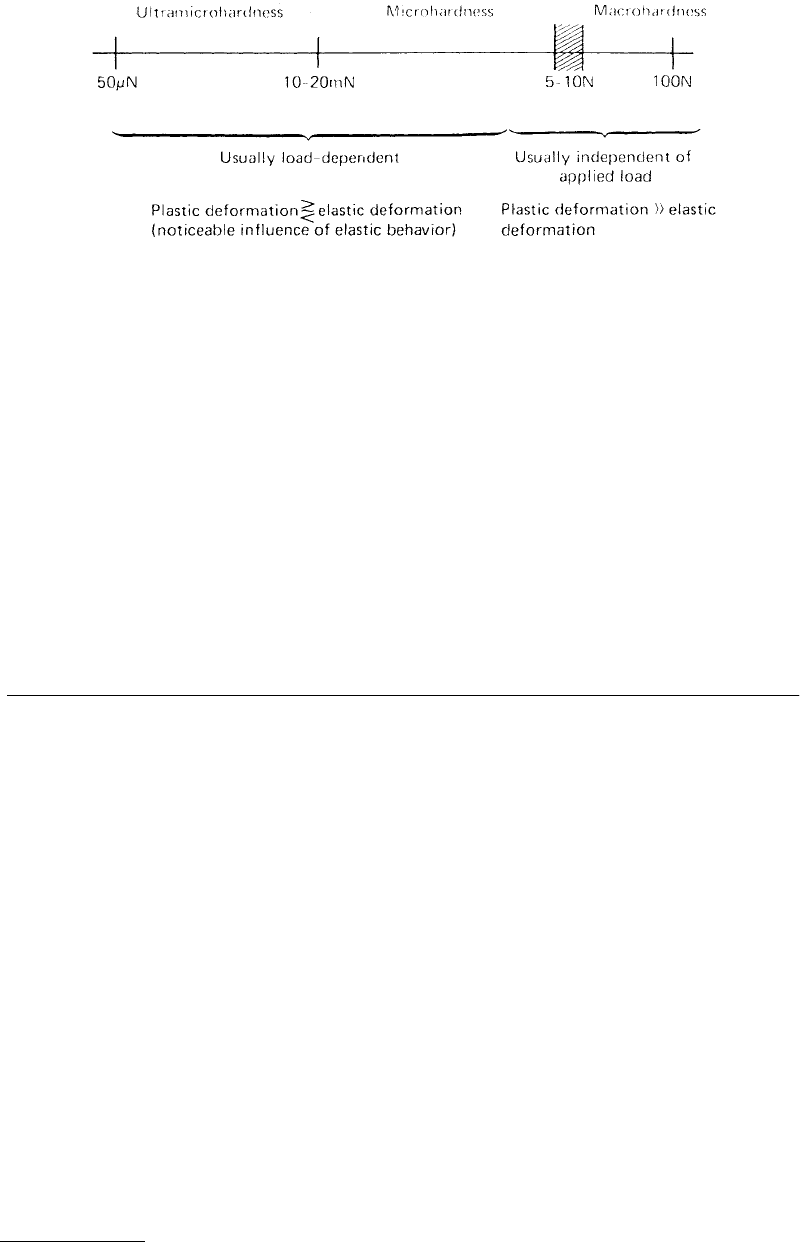
© 1999 by CRC Press LLC
available is about 10 mN. Loads on the order of 50 µN to 1 mN are desirable if the indentation depths
are to remain few tens of a nanometer. In this case, the indentation size sometimes reaches the resolution
limit of a light microscope, and it is almost impossible to find such a small imprint if the measurement
is made with a microscope after the indentation load has been removed. Hence, either the indentation
apparatuses are placed
in situ
and a scanning electron microscope (SEM) or
in situ
indentation depth
measurements are made. The latter measurements, in addition, would offer the advantages to observe
the penetration process itself. In viscoelastic/visoplastic materials, since indentation size changes with
time,
in situ
measurements of the indentation size are particularly useful, which can, in addition, provide
more complete creep and relaxation data of the materials.
In this chapter, we will review various prototype and commercial nanoindentation hardness test
apparatuses and associated scratch capabilities for measurements of mechanical properties of surface
layers of bulk materials and extremely thin films (submicron in thickness). A commercial depth-sensing
nanohardness test apparatus will be described in detail followed by data analysis and use of nanohardness
apparatuses for determination of various mechanical properties of interest.
10.2 Nanoindentation Hardness Measurement Apparatuses
In this section, we review nanoindentation hardness apparatuses in which the indent is imaged after the
load has been removed as well as the depth-sensing indentation apparatuses in which the load-indentation
depth is continuously monitored during the loading and unloading processes. Earlier work by Alekhin
et al. (1972), Ternovskii et al. (1973), and Bulychev et al. (1975, 1979) led to the development of depth-
sensing apparatuses. Both prototype and commercial apparatuses are reviewed. A commercial depth-
sensing nanoindentation hardness test apparatus manufactured by Nano Instruments, Inc., is extensively
used and is described in detail.
10.2.1 Commercial Nanoindentation Hardness Apparatuses
with Imaging of Indents after Unloading
For completeness, we first describe a commercially available microindentation hardness apparatus (Model
No. Micro-Duromet 4000) that uses a built-in light optical microscope for imaging of indents after the
sample is unloaded. It is manufactured by C. Reichert Optische Werke AG, A-1171, Vienna, Box 95,
Austria, Figure 10.2 (Pulker and Salzmann, 1986). The case of the indenter is of the size of a microscope
objective mounted on the objective revolver. The load range for this design is from 0.5 mN to 2 N;
therefore, it is used for thicker films.
A commercial nanoindentation hardness apparatus for use inside an SEM (Model No. UHMT-3) for
imaging the indents after the sample is unloaded, is manufactured by Anton Paar K.G., A-8054, Graz,
Austria. The apparatus is mounted on the goniometer stage of the SEM. In this setup, the indenter is
FIGURE 10.1
Extended load range of static indentation hardness testing.
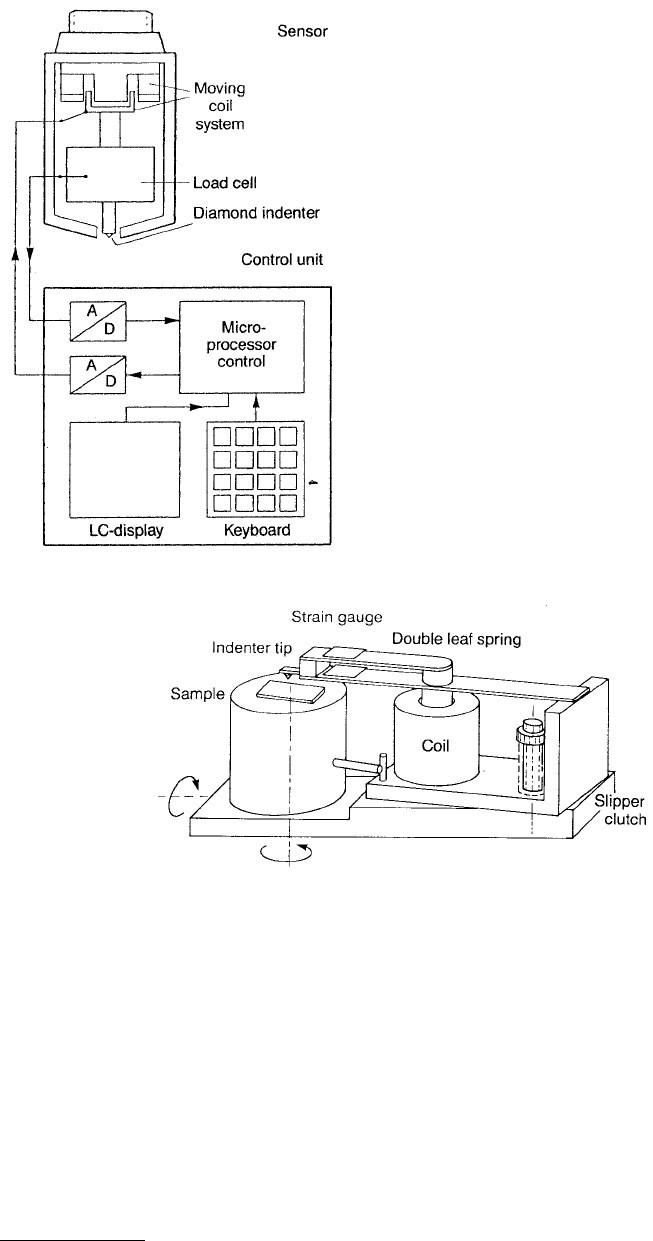
© 1999 by CRC Press LLC
mounted on a double-leaf spring cantilever and is moved against the sample by an electromagnetic system
to attain the required indentation load, which is measured by strain gauges mounted on the leaf springs,
Figure 10.3 (Bangert et al., 1981; Bangert and Wagendristel, 1986). Tilting the stage with respect to the
electron beam allows observation of the tip during the indentation process. The indentation cycle is fully
programmable and is controlled by the strain gauge signal. The motion of the indenter, perpendicular
to the surface, is performed by increasing the coil current until a signal from the strain gauges is detected.
Further, an increase of the current up to a certain gauge signal leads to the desired indentation force
ranging from 50 µN to 20 mN. After the required load has been reached and the dwell time has elapsed,
the sample is unloaded, and the indentation diagonal is measured by an SEM.
FIGURE 10.2
Schematic of the microindentation hardness
apparatus for use in a light optical microscope. (From Pulker,
H.K. and Salzmann, K., 1986,
SPIE Thin Film Technol.
652,
139–144. With permission.)
FIGURE 10.3
Schematic of the nanoindentation hardness apparatus for use in an SEM by Anton Parr K.G., Graz,
Austria. (From Bangert, H. et al., 1981,
Colloid Polym. Sci.
259, 238–242. With permission.)
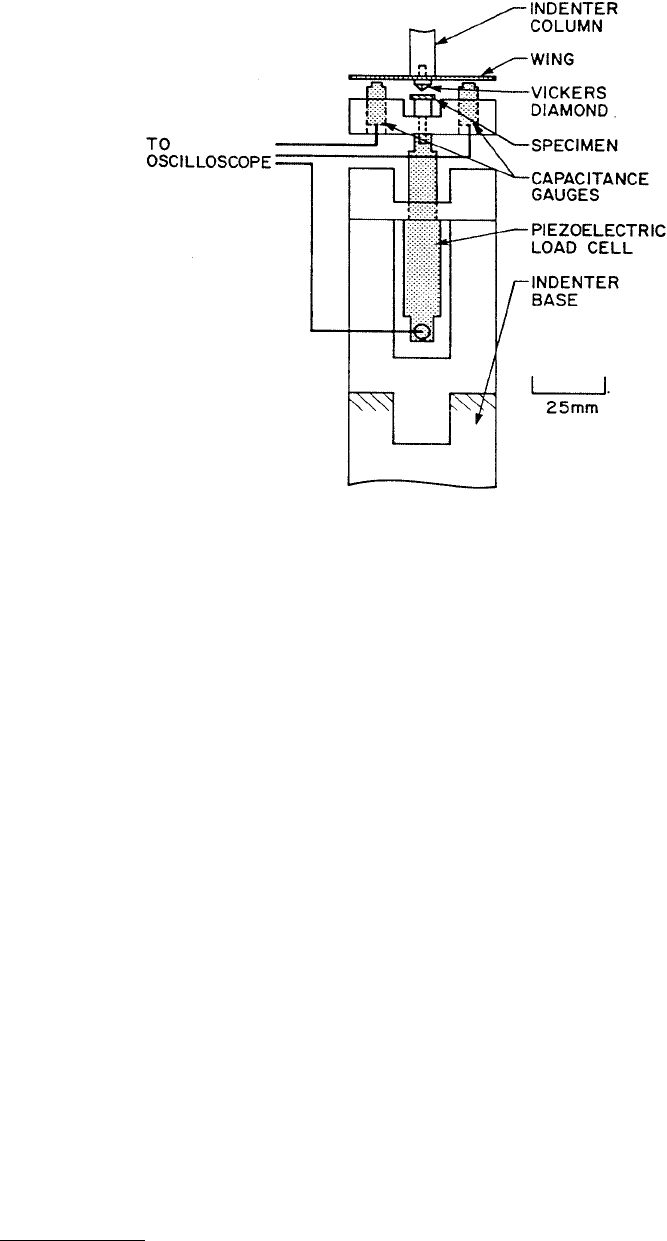
© 1999 by CRC Press LLC
10.2.2 Prototype Depth-Sensing Nanoindentation
Hardness Apparatuses
Of all the nanohardness apparatuses described in this section, the apparatus designs by IBM Almaden
Research Center and Nano Instruments, Inc., are the most modern apparatuses with the largest range of
test capabilities. However, the IBM Almaden apparatus is not commercially available. The apparatus built
by MTS Nano Instruments Innovation Center which is called the Nanoindenter, is commercially available
and is comparable to the IBM Almaden design with complete software. Nanoindenter is most commonly
used by the industrial and academic research laboratories. It will be described in some detail. The NEC
design is commercially available; however, this has limited capabilities and is not popular.
10.2.2.1 IBM T.J. Watson Research Center Microhardness Tester Design
The apparatus to be described here is a “microhardness apparatus” and is only included here for com-
pleteness. Pharr and Cook (1990) instrumented a conventional microhardness tester to measure inden-
tation load and penetration depth during the entire indentation process, Figure 10.4. This modified
machine has the advantage of being relatively inexpensive since many of its components are standard
equipment.
Pharr and Cook used a Buehler Micromet II machine with a load range of 0.1 to 10 N although other
commercially available units can be used. In their modifications, load was measured with a piezoelectric
load cell (Kistler model 9207) with a resolution of 0.5 mN and a maximum load of 50 N. The load cell
was conditioned by a Kistler model 5004 charge amplifier with a frequency response of about 180 kHz.
Displacement was measured with two capacitec model HPC-75 capacitance gauges with matching ampli-
fier and conditioner (model 3201). These gauges have high resolution of about 0.05 µm and frequency
response of 10 kHz. The sample stage was replaced with an assembly in which the load cell could be
rigidly supported. A mount for the displacement gauges was then connected directly to the top of the
FIGURE 10.4
Schematic of a modified commercial microhardness test apparatus for load-penetration depth mea-
surements. (From Pharr, G.M. and Cook, R.F., 1990,
J. Mater. Res.
5, 847–851. With permission.)
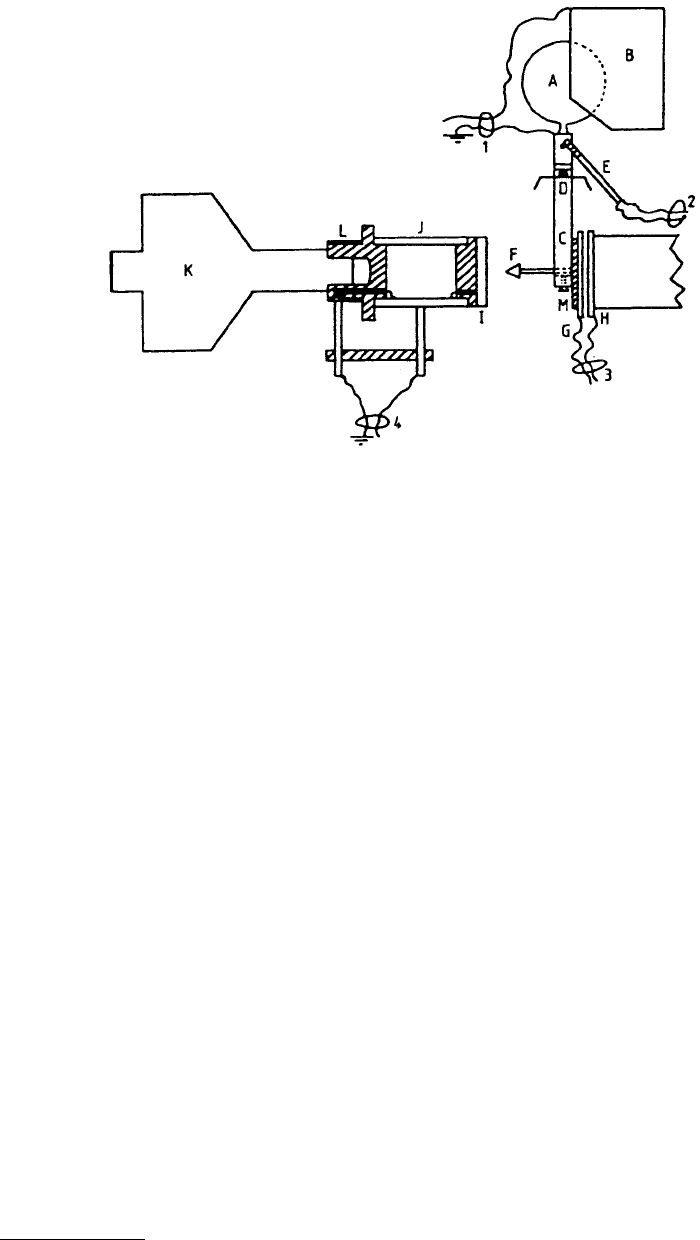
© 1999 by CRC Press LLC
load cell. The specimen was attached to the center of this mount with the displacement gauges flanking
it on either side. The gauges sensed the motion of a thin aluminum wing rigidly attached to the base of
the moving diamond and its mount. The outputs from the displacement gauges were averaged so as to
negate any displacements caused by bending in the system. The load and displacement outputs were
measured using a storage oscilloscope.
In a typical experiment, the load and displacement signals were recorded as a function of time, with
the load–displacement curve derived subsequently from these data. This modified apparatus can only be
used for loads as low as about 100 mN, making it useful for only microhardness measurements.
10.2.2.2 AERE Harwell/Micro Materials Design
Newey et al. (1982) developed an apparatus capable of continuously monitoring the penetration depth
as the load is applied, Figure 10.5. The test sample I is mounted on a piezoelectric barrel transducer J,
their horizontal position being controlled by a micrometer movement K. A high-voltage supply is
connected to the transducer J by means of a commutator arrangement. The indenter assembly C is made
from folded tantalum foil to give a light structure, and is fitted with tungsten pivots seated in jeweled
bearings D, from which it is suspended. Force is applied electrostatically by increasing the potential on
the two plates B; force plate A is part of indenter assembly C and is kept at ground potential. The resulting
force causes A to move into B and indenter F to move toward the specimen. The indentation depth is
measured with a capacitor bridge arrangement. Plates G and H for measurement of indenter motion,
are concentric with the axis of the indenter holder and form part of a capacitor bridge arrangement
(plate G is insulated from C by mica sheet M). E is a piezoelectric bimorph transducer used to restrain
the indenter assembly C when the specimen is being moved toward the indenter. In the modified design
reported by Pollock et al. (1986), the specimen can be transferred between two locations (test and
microscopic observation). A particular area of interest may therefore be identified in the microscope and
then transferred to the test position.
This instrument is commercially available as Nano Test 550 from Micro Materials, Unit 3, The Byre,
Wrexham Technology Park, Wrexham, Clywd, U.K. In this apparatus, an indentation load up to 500 mN
with a resolution of 10 µN can be applied and the depth resolution measurement is better than 0.1 nm.
FIGURE 10.5
Schematic of a depth-sensing nanoindentation hardness apparatus by Newey et al. (From Newey, D.
et al., 1982,
J. Phys. E: Sci. Instrum.
15, 119–122. With permission.)
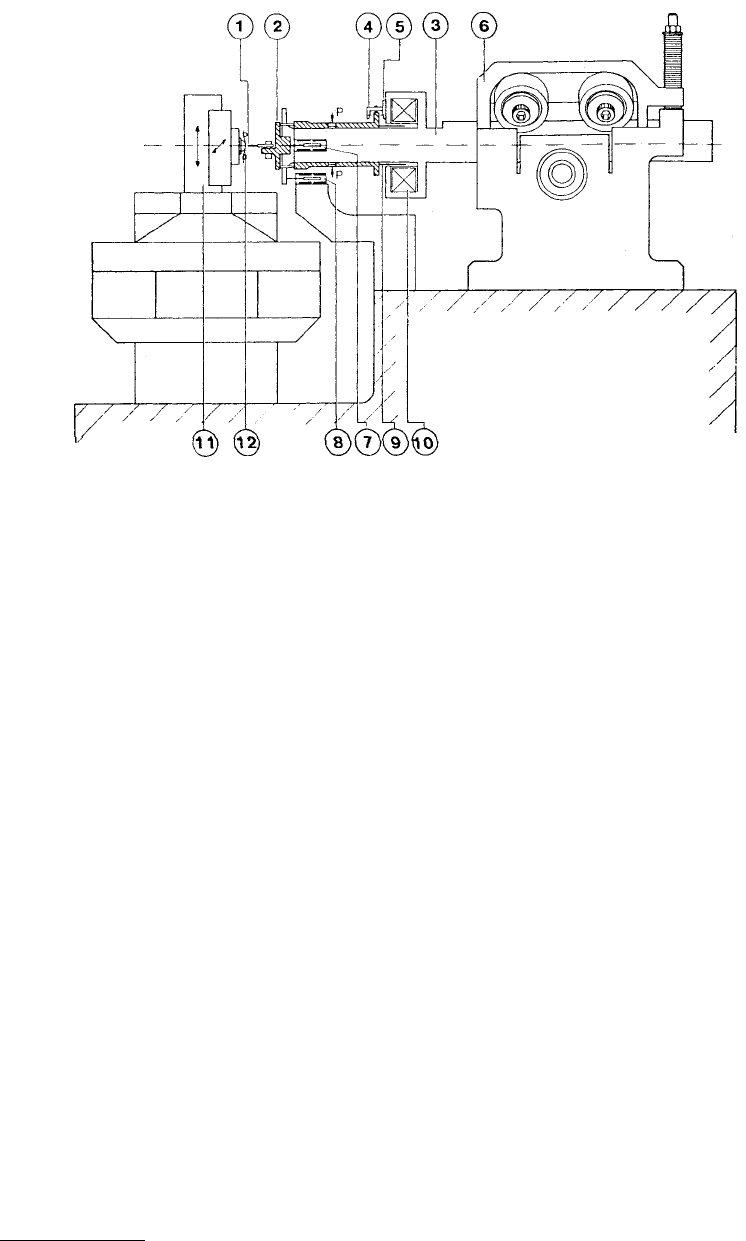
© 1999 by CRC Press LLC
10.2.2.3 Philips Research Laboratory Design
Wierenga and Franken (1984) built a nanoindentation apparatus that measures
in situ
the indenter
penetration as a function of time (relaxation testing) or load with a resolution of 5 nm, Figure 10.6. The
indentation force can be varied from 10 µN to 5 mN. Indenter (1) is clamped to the holder (2) and can
easily be exchanged. The indenter holder (2) supported on an air bearing can be moved virtually
frictionlessly along a horizontal shaft (3). Two stops (4 and 5) attached to the shaft limit the movement
of the holder. The shaft is supported by a linear drive mechanism (6) making use of friction wheels and
guide rollers. The apparatus is equipped with two inductive displacement transducers (7 and 8) which
measure the displacement of the indenter with respect to the shaft and of the shaft with respect to the
surroundings, respectively. The signal from transducer 8 is automatically corrected for changes in the
ambient temperature during an experiment. This is done by the application of a temperature-sensing
element mounted on transducer 8. The indenter force is adjusted by means of an electromagnetic system.
A coil (9) is attached to the indenter holder and can move in the annular gap of an electromagnet (10),
which is mounted on the shaft. The sample holder (11) can be moved in two directions perpendicular
to the axis of the shaft (3). Samples are held by using an accessory (12) which is held by suction to the
sample holder. (Also see Wierenga and van der Linden, 1986.)
For an indentation experiment, the indenter is first brought into contact with the sample. For this
purpose, transducer 7 is adjusted to give a zero signal when the stylus holder is somewhere between stops
4 and 5. By switching on the motor of the linear drive mechanism, the shaft and indenter are moved
toward the sample. After the indenter has touched the sample surface, movement of the shaft is auto-
matically halted when the signal from transducer 7 equals zero. The starting position for an indentation
experiment is achieved by moving the sample a short distance sideways at a minimum indenter force. If
the indenter force is increased, the signal from transducer 7 is kept to zero with the control system by
moving the shaft. Thus, the penetration depth can be determined with transducer 8, which measures the
displacement of the shaft with respect to the frame.
FIGURE 10.6
Schematic of a depth-sensing nanoindentation hardness apparatus by Philips Laboratory, Eindhoven,
The Netherlands: (1) indenter, (2) indenter holder, (3) central shaft, (4) and (5) stops, (6) linear drive mechanism,
(7) and (8) displacement transducers, (9) coil, (10) electromagnet, (11) sample holder, (12) accessory for holding
the sample (From Wierenga, P.E. and van der Linden, J. H. M., 1986, in
Tribology and Mechanics of Magnetic Storage
Systems,
Vol. 3 (B. Bhushan and N.S. Eiss, eds.), pp. 31–37, SP-21, ASLE, Park Ridge, IL. With permission.)

© 1999 by CRC Press LLC
10.2.2.4 IBM Corporation/University of Arizona Tucson Design
Bhushan et al. (1985, 1988) and Williams et al. (1988) built a nanoindentation apparatus that can
independently control and measure indentation depths with a resolution of 0.2 nm and loads with a
resolution of 30 µN
in situ
, Figure 10.7. Samples and indenter positions are measured with a specially
designed polarization interferometer. A minimum load of about 0.5 mN can be applied. In the apparatus,
the test sample is clamped to the top of a mirror that is kinematically mounted to the moving stage of
a damped parallel spring guide. The spring guide ensures smooth, low-friction, vertical motion. A linear
actuator nested inside the parallel spring guide drives the moving stage vertically. The indenter is sus-
pended above the sample and screws into the bottom of the moving stage of another damped parallel
spring guide. Another mirror is kinematically mounted to the top of this stage. The indenter spring guide
is independently calibrated and checked for linearity so that the indenter load can be correctly inferred.
Both spring guides are damped to prevent oscillations and utilize auxiliary counterbalance springs to
keep the spring guides close to their neutral, unstressed position, where their motion is linear.
The vertical positions of the sample and indenter mirrors and thus the positions of the sample and
indenter are monitored independently by the polarization interferometer. Light from a helium–neon
laser enters the polarization interferometer where the light beam is separated by a diffraction grating
into seven separate beams, six equally spaced beams on a 12-mm-diameter circle and one in the center
of the circle, which serves as the reference (Williams et al., 1988). Leaving the interferometer, the beams
pass through a beam expander to enlarge the beam circle diameter. Three of the outer beams strike the
indenter mirror and the other three pass through holes in the indenter mirror and stage and strike the
sample mirror. Because of the large beam circle diameter, the beams avoid striking the central obstruc-
tions, the sample, and the indenter. The light reflected from both mirrors then returns to the interfer-
ometer. Thus, the positions of the sample and indenter mirrors are continuously monitored by comparing
the relative phases of the light beams returning from the mirrors to the central reference beam. The
computer subtracts the positions of the two mirrors to determine the resulting indentation depth and
multiplies the indenter mirror position and the spring constant of the indenter parallel spring guide to
determine the indentation load.
To initiate a test, the actuator slowly raises the sample toward the indenter until motion is registered
by the interferometer, implying that contact has been made between the sample and the indenter. The
control loop then takes over and performs the chosen test — it either keeps the load constant and
measures the penetration depth as a function of time or it keeps the depth constant and measures the
load as a function of time.
10.2.2.5 NEC, Kawasaki Design
Tsukamoto et al. (1987) and Yanagisawa and Motomura (1987, 1989) developed a nanoindentation
hardness apparatus. NEC Corp., Kawasaki 216, Japan is attempting to commercialize it, although it is
not popular, Figure 10.8. It consists of three parts: an indenter actuator, a load detector, and a displace-
ment sensor. Indenter (1) with a diamond tip is attached to stylus (2) which is clamped on holder (3).
The holder is attached to a piezoelectric actuator (4), which drives the holder up and down controlled
by a personal computer (5) through an amplifier (6), a regulated power source (7), and an interface (8).
Indentation load is detected by a digital electrobalance (9) with a 1-µN resolution at loads of up to
300 mN. The output signal is fed to the
X
-axis of an
X
–
Y
recorder (10). A sample (11) is placed on a
sample disk (12). Penetration depth is detected by a fiber-optic displacement instrument (13) with a
4-nm displacement resolution. Light from a tungsten lamp in the displacement instrument is irradiated
onto a mirror (15) through an optical fiber (14). The intensity of the reflected light from the mirror on
the sample disk is measured by a photodetector in the displacement instrument and reduced to a
displacement between the indenter and the sample. An output signal from the displacement instrument
is connected to the
Y
-axis of the
X
–
Y
recorder. The apparatus is surrounded by a metal box (20) to minimize
the influence of air currents and heat radiation. It is placed on a vibration-isolation air table (16).
For an indentation experiment, the indenter is first brought into contact with the sample by a micro-
meter (17). When contact is detected with the sample by the electrobalance, the distance between the
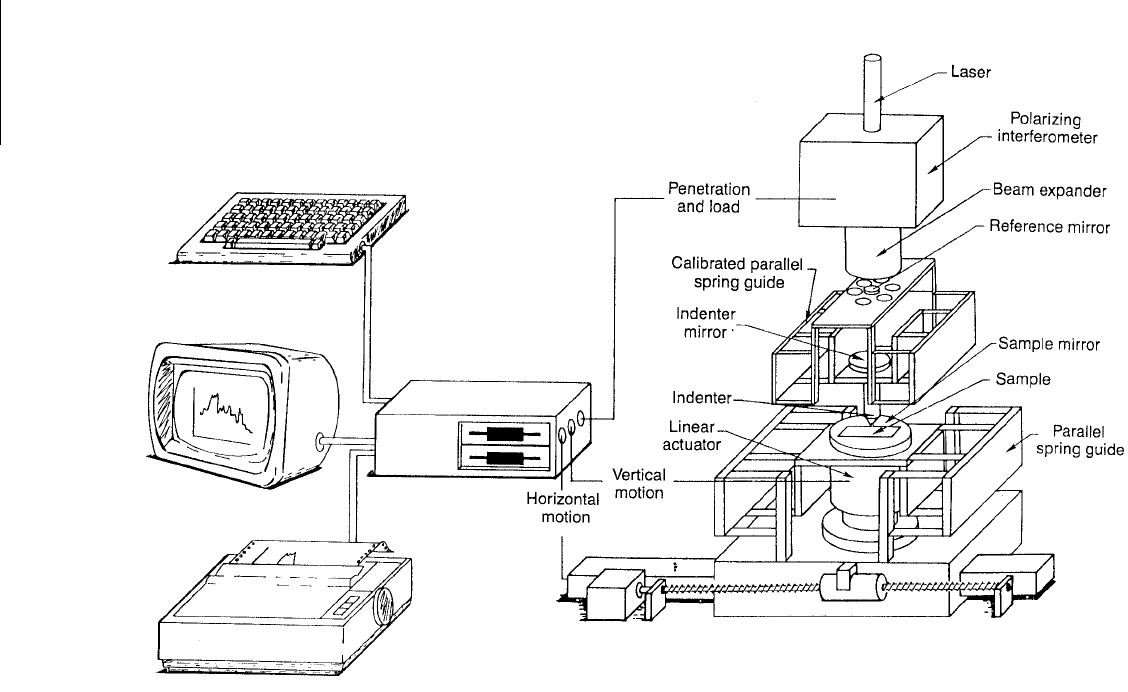
© 1999 by CRC Press LLC
FIGURE 10.7
Schematic of a depth-sensing nanoindentation hardness apparatus by IBM Corporation, Tucson, and University of Arizona, Tucson,
AZ. (From Bhushan, B. et al., 1988,
ASME J. Tribol.
110, 563–571. With permission.)
